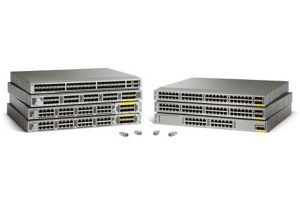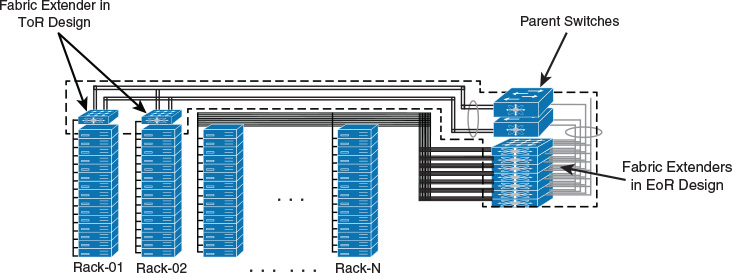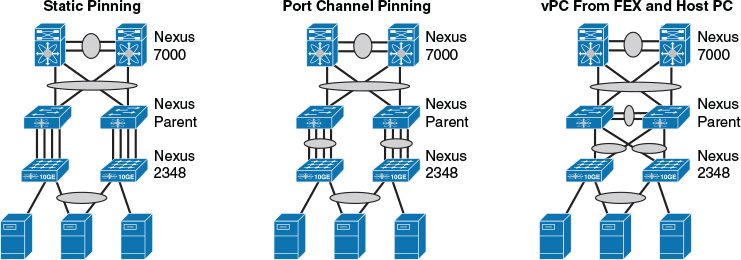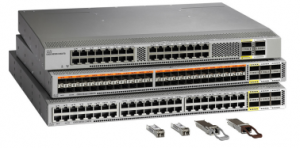
- The Cisco Nexus 2000 Fabric Extenders behave as remote line cards. They appear as an extension to the parent switch to which they connect.

- The parent switch can be Nexus 5000, Nexus 6000, Nexus 7000, and Nexus 9000 Series switches.
- Using Nexus 2000 gives you great flexibility when it comes to the type of connectivity and physical topology.
- This type of architecture provides the flexibility and benefit of both architectures: top-of-rack (ToR) and end-of-row (EoR).
- It also enables highly scalable servers access design without the dependency on spanning tree.
- All Nexus 2000 Fabric Extenders connected to the same parent switch are managed from a single point. Figure1 shows both types, ToR and EoR.
Figure1 Cisco Nexus 2000 Top-of-Rack and End-of-Row Design

As shown in Figure1, Rack-01 is using a dual-redundant Cisco Nexus 2000 Series Fabric Extender, which is placed at the top of the rack. The uplink ports on the Cisco Nexus 2000 Series Fabric Extenders can be connected to a Cisco Nexus 5000, Nexus 6000, Cisco Nexus 7000, or Nexus 9000 Series switch that is installed in the EoR position as the parent switch.
This is a ToR design from a cabling point of view, but from an operation point of view this design looks like an EoR design, because all these Nexus 2000 Fabric Extenders will be managed from the parent switch. So no configuration or software maintenance tasks need to be done with the FEXs. The cabling between the servers and the Cisco Nexus 2000 Series Fabric Extenders is contained within the rack, thus reducing cabling between racks. Only the cables between the Nexus 2000 and the parent switches will run between the racks, which can be 10 Gbps or 40 Gbps.
Multiple connectivity options can be used to connect the FEX to the parent switch, as shown in Figure2, which is explained shortly.
Figure2 Cisco Nexus 2000 Connectivity Options

- Straight-through, using static pinning: To achieve a deterministic relationship between the host port on the FEX to which the server connects and the fabric interfaces that connect to the parent switch, the host port will be statically pinned to one of the uplinks between the FEX and the parent switch. This method is used when the FEX is connected straight through to the parent switch. The server port will always use the same uplink port.
- You must use the pinning max-links command to create pinned fabric interface connections so that the parent switch can determine a distribution of host interfaces. The host interfaces are divided by the number of the max-links and distributed accordingly. The default value is max-links equals 1.
NOTE: The Cisco Nexus 2248PQ Fabric Extender does not support the static pinning fabric interface connection.
- Straight-through, using dynamic pinning (port channel): You can use this method to load balance between the down link ports connected to the server and the fabric ports connected to the parent switch. This method bundles multiple uplink interfaces to one logical port channel. The traffic is being distributed using a hashing algorithm. For Layer 2, it uses Source MAC and Destination MAC; for Layer 3, it uses Source MAC, Destination MAC, and Source IP Destination IP.
- Active-active FEX using vPC: In this scenario, the FEX is dual homed using vPC to different parent switches.
NOTE: The Cisco Nexus 7000 Series switches currently support only straight-through deployment using dynamic pinning. Static pinning and active-active FEX are currently supported only on the Cisco Nexus 5000 Series switches.
The following tables compare Cisco Nexus 2000 Series models.
Compare Nexus 2000 Models-1 GE Fabric Extender
| Cisco Nexus 2348UPQ | Cisco Nexus 2248PQ | Cisco Nexus 2232PP | |
| Fabric extender host interfaces | 48 | 48 | 32 |
| Fabric extender host interface types | 1/10 GE ports SFP/SFP+ | 1/10 GE ports SFP/SFP+ | 1/10 GE ports SFP/SFP+ |
| Fabric extender fabric interfaces | 2 to 6 40 GE QSFP (24 x 10 GE) | 4 QSFP+ (16 x 10 GE) | 8 |
| Fabric speed | Up to 240 Gbps in each direction (480 Gbps full duplex) | 160 Gbps in each direction (320 Gbps full duplex) | 80 Gbps in each direction (160 Gbps full duplex) |
| Oversubscription | 2:1 | 3:1 | 4:1 |
| Performance | Hardware forwarding at 1440 Gbps or 2160 mpps | Hardware forwarding at 1280 Gbps or 952 mpps | Hardware forwarding at 800 Gbps or 595 mpps |
| Cisco parent switch | Cisco Nexus 5000, 6000, 7000, or 9000 Series* | Cisco Nexus 5000, 6000, 7000, or n9000 Series* | Cisco Nexus 5000, 6000, 7000, or n9000 Series* |
| FCoE support | Yes | Yes | Yes |
| Unified port capable | Yes | No | No |
| Airflow | Port-side exhaust and port-side intake | Port-side exhaust and port-side intake | Port-side exhaust and port-side intake |
| Buffers | 32 MB shared | 32 MB network to host, 8 MB host to network |
8 MB |
Compare Nexus 2000 Models-10GBASE-T Fabric Extender
| Cisco Nexus 2332TQ | Cisco Nexus 2348TQ | Cisco Nexus 2348TQ-E | Cisco Nexus 2232TM-E | Cisco Nexus 2232TM | |
| Fabric extender host interfaces | 32 | 48 | 48 | 32 | 32 |
| Fabric extender host interface types | 100BASE-T, 1/10GBASE-T ports: RJ‑45 connectors | 100BASE-T, 1/10GBASE-T ports: RJ‑45 connectors | 100BASE-T, 1/10GBASE-T ports: RJ‑45 connectors | 1/10GBASE-T ports: RJ-45 connectors | 1/10GBASE-T ports: RJ-45 connectors |
| Fabric extender fabric interfaces | 4 40 GE QSFP (16 x 10 GE) | 6 40 GE QSFP (24 x 10 GE) | 6 40 GE QSFP (24 x 10 GE) | 8 SFP+ | Uplink module: 8 SFP+ |
| Fabric speed | Up to 160 Gbps of switching capacity in each direction (320 Gbps full duplex) | Up to 240 Gbps in each direction (480 Gbps full duplex) | Up to 240 Gbps in each direction (480 Gbps full duplex) | 80 Gbps in each direction (160 Gbps full duplex) | 80 Gbps in each direction (160 Gbps full duplex) |
| Oversubscription | 2:1 | 2:1 | 2:1 | 4:1 | 4:1 |
| Performance | Hardware forwarding at 960 Gbps or 1440 mpps | Hardware forwarding at 1440 Gbps or 2160 mpps | Hardware forwarding at 1440 Gbps or 2160 mpps | Hardware forwarding at 800 Gbps or 595 mpps | Hardware forwarding at 800 Gbps or 595 mpps |
| Cisco parent switch | Cisco Nexus 5000, 6000, 7000, and 9000 Series* | Cisco Nexus 5000, 6000, 7000, and 9000 Series* | Cisco Nexus 5000, 6000, 7000, and 9000 Series* | Cisco Nexus 5000, 6000, 7000, or 9000 Series* | Cisco Nexus 5000, 6000, 7000, or 9000 Series* |
| FCoE support | Yes (supports up to 30 meters) | Yes (supports up to 30 meters) | Yes (supports up to 30 meters) | Yes (Supports up to 30 meters) | No |
| Airflow | Port-side exhaust and port-side intake | Port-side exhaust and port-side intake | Port-side exhaust and port-side intake | Port-side exhaust and port-side intake | Port-side exhaust and port-side intake |
| Buffers | 32 MB shared | 32 MB Shared | 32 MB Shared | 8 MB | 8 MB |
Compare Nexus 2000 Models-10G SFP+ Fabric Extender
| Cisco Nexus 2348UPQ | Cisco Nexus 2248PQ | Cisco Nexus 2232PP | |
| Fabric extender host interfaces | 48 | 48 | 32 |
| Fabric extender host interface types | 1/10 GE ports SFP/SFP+ | 1/10 GE ports SFP/SFP+ | 1/10 GE ports SFP/SFP+ |
| Fabric extender fabric interfaces | 2 to 6 40 GE QSFP (24 x 10 GE) | 4 QSFP+ (16 x 10 GE) | 8 |
| Fabric speed | Up to 240 Gbps in each direction (480 Gbps full duplex) | 160 Gbps in each direction (320 Gbps full duplex) | 80 Gbps in each direction (160 Gbps full duplex) |
| Oversubscription | 2:1 | 3:1 | 4:1 |
| Performance | Hardware forwarding at 1440 Gbps or 2160 mpps | Hardware forwarding at 1280 Gbps or 952 mpps | Hardware forwarding at 800 Gbps or 595 mpps |
| Cisco parent switch | Cisco Nexus 5000, 6000, 7000, or 9000 Series* | Cisco Nexus 5000, 6000, 7000, or n9000 Series* | Cisco Nexus 5000, 6000, 7000, or n9000 Series* |
| FCoE support | Yes | Yes | Yes |
| Unified port capable | Yes | No | No |
| Airflow | Port-side exhaust and port-side intake | Port-side exhaust and port-side intake | Port-side exhaust and port-side intake |
| Buffers | 32 MB shared | 32 MB network to host, 8 MB host to network |
8 MB |
*Software support for all parent switches may not yet be available. Check Cisco NX-OS Software release notes for the specific parent switch models and minimum required software version.
Get the Best Prices on Cisco Nexus 2000 Models
End-of-Sale Models
Cisco Nexus 2248PQ 10GE Fabric Extender
Cisco Nexus 2248TP GE Fabric Extender
Cisco Nexus 2232TM 10GE Fabric Extender
Cisco Nexus 2224TP GE Fabric Extender
Cisco Nexus 2148T Fabric Extender
More Related
Nexus 3000 Model Comparison & Licensing Options
New, Cisco Nexus 3600 Models-C36180YC-R and 3636C-R
Cisco Nexus 5500 and Nexus 5600-Model Features
Cisco Nexus 5500 and Nexus 5600 Licensing Options
Feature-Based Licenses for the Cisco Nexus 5000, Nexus 5500 and Nexus 5600 Series
Cisco Nexus 7000 and Nexus 7700 Modular Switches, the Main Chassis
Cisco’s Data Center Architecture
Cisco Nexus 7000 and Nexus 7700 Series Power Supply Options
Cisco Nexus 7000 and Nexus 7700 Supervisor Module
Cisco Nexus 7000 and Nexus 7700 Licensing
Cisco Nexus Positioning: 2 and 3 Tier
The Latest Cisco Nexus 9000 Innovations


